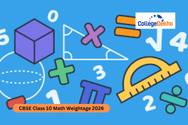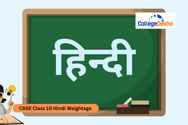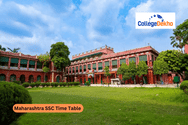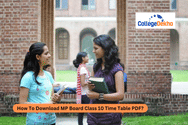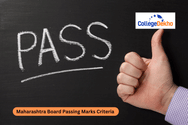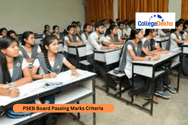AP SSC Syllabus 2026 helps you to check the detailed curriculum for the exams. The PDF uploaded by BSE AP includes an action plan and question banks for effective preparation.


Never Miss an Exam Update
About AP SSC Syllabus 2025-26
Board of Secondary Education Andhra Pradesh will release the syllabus in PDF on their official website. Students are required to refer to the latest syllabus when preparing for the exam. The theory papers for AP SSC students will be conducted for 100 marks, and mostly, there will be no practical exams. Students are required to score 35% marks in each subject to be eligible for the passing certificate. AP SSC includes three languages and 3 non-language subjects. The non-language subjects include Mathematics, Science, and Social Science. Students can also check out the latest AP SSC Exam Pattern 2025-26 for reference. Check out more information about the AP SSC Syllabus 2025-26 here:
Latest Updates:
- Nov 24, 2025: The Board of Secondary Education, Andhra Pradesh, released the AP SSC time table 2026 on November 21, 2025, on the official website. The AP SSC examination 2026 will be held from March 16 to April 1, 2026, in pen and paper mode. The exams are scheduled to be held in single shifts from 9:30 AM to 12:45 PM.
AP SSC Syllabus 2025-26 PDF
Board of Secondary Education Andhra Pradesh has released new PDFs that include an Action Plan, question banks, and the latest model test papers to help the students. You can refer to these PDFs from the table given below and use them to check the latest curriculum:
Subjects | PDF Links |
|---|---|
Success Minor Languages Book | |
Success Languages Book | |
Success Non Languages Book |
How to Download AP 10th Class Syllabus 2025–26
Students can easily download the AP SSC (10th Class) syllabus for the academic year 2025–26 by following a few simple steps. The syllabus is available in PDF format and can be accessed on any device. Here's how to get it:- Go to the official website – bse.ap.gov.in
- Look for the "Student Services" section on the homepage.
- Click on the link for the SSC Syllabus.
- A new page will open with subject-wise syllabus PDFs.
- Click on the desired subject link to view or download the syllabus.
- Save the file for easy access while studying.
AP SSC Syllabus 2025-26 for English
Reading, writing, grammar, and literature are all covered in the English curriculum. The syllabus will assist students in improving their reading, writing, and comprehension skills. The detailed AP SSC English Syllabus 2025-26 is listed below.
Sections | Topics |
|---|---|
Reading | Three passages of about 650 words. |
Writing | Notice, message, Telegram, and Short postcard. |
Grammar |
|
Literature |
|
AP SSC Math Syllabus 2025-26
Students can refer to the detailed information about the AP SSC Math Syllabus 2025-26 from the table given below:
Chapters |
|---|
Chapter 1 - Real Numbers |
Chapter 2 - Sets |
Chapter 3 - Polynomials |
Chapter 4 - Pair of Linear Equations in Two Variables |
Chapter 5 - Quadratic Equations |
Chapter 6 - Progressions |
Chapter 7 - Coordinate Geometry |
Chapter 8 - Similar Triangles |
Chapter 9 - Tangents and Secants to a Circle |
Chapter 10 - Mensuration |
Chapter 11 - Trigonometry |
Chapter 12 - Applications of Trigonometry |
Chapter 13 - Probability |
Chapter 14 - Statistics |
AP SSC Science Syllabus 2025-26
Students can refer to the AP SSC Science Syllabus 2025-26 for each paper from the table given below:
Physical Science
Unit | Sub - Topics |
|---|---|
|
Spherical mirrors, convex and concave mirrors Pole, Focus, Centre of curvature, principle axis, Radius of curvature, Focal length Formula for spherical mirrors – sign convention Application of reflection – Solar Cooker, etc. |
|
Chemical equations – writing chemical equations, skeletal chemical equations, balancing chemical equations Writing symbols of physical states, Heat changes, gas evolved and precipitate formed Interpreting a balanced chemical equation |
|
What do acids have in common? What do bases have in common? Do Acids produce Ions only in Aqueous Solution? Reaction of Acid, Base with water Strength of Acid or Base – pH scale Importance of pH in everyday life Salts Chemicals from common salt |
|
Lenses Rules for Ray diagram Images formed by the lenses Formula derived for thin lenses Focal length of lens depends on the surrounding medium Lens maker formula |
5. Human eye and colourful world |
Structure of human Eye – Focal length of human Eye lens, accommodation Common accommodation defects of vision – Myopia, Hypermetropia, presbyopia Prism Scattering of light |
6. Structure of atom |
Electromagnetic Spectrum Bohr’s model of a Hydrogen atom and its limitations Quantum mechanical model of an Atom Electronic Configuration of elements in their atoms nl rule, Energies of electronic energy levels (n+l) rule; Aufbau Principle, Pauli’s principle, Hund’s Rule of maximum multiplicity, Stable configurations |
7. Classification of Elements – The Periodic Table |
Doberieners Triads – Limitations Newland’s law of Octaves Mendeleev’s Periodic Table (Periodic law, Achievements & Limitations) Modern Periodic Table. |
8. Chemical Bonding |
Electronic theory of Valence by Lewis and Kossel Ionic and Covalent bonds: examples with Lewis Dot formulae The arrangement of Ions in Ionic compounds Factors affecting the formation of cation and anion Shapes, bond lengths and bond energies in molecules Valence shell electron pair repulsion theory Valence bond theory Properties of Ionic and Covalent Compounds |
9. Electric Current |
Potential difference How a battery or a cell works Ohms law and its limitations, resistance, specific resistance, factors influencing resistance, electric shock Electric Circuits Electric power Safety fuses |
10. Electromagnetism |
Magnetic field – field lines Magnetic field due to currents Magnetic force on moving charge and current carrying wire Electric motor Electromagnetic induction – Faraday’s law (including magnetic flux) – Lenz law Generators and Alternating – Direct Currents |
11. Principles of Metallurgy |
Extraction of metals from the Ores – activity series and related metallurgy, flow chart of steps involved in the extraction of metals from ore. Corrosion – Prevention of Corrosion Important Processes used in metallurgy Flux Furnace |
12. Carbon and its compounds | Introduction of Carbon compounds Promotion of an Electron – Bonding in Carbon including Hybridization Allotropes of Carbon Versatile nature of carbon Hydrocarbons Bonding of carbon with other elements Isomerism Homologous series Nomenclature of carbon compounds Chemical properties of carbon compounds Important carbon compounds Esterification reactions Soaps – Saponification, Micelles |
Biology
| Units | Chapters |
|---|---|
Nutrition | Life Process- Introduction Photosynthesis Nutrition in organisms Digestion in human beings Healthy points about oesophagus Malnutrition |
Respiration |
Respiratory system in human being Cellular respiration Respiration – Combustion Evolution of gaseous exchange Plant respiration |
Transportation |
Cardiac cycle Lymphatic system Evolution of transport system Blood pressure Blood clotting Transportation in plants |
Excretion | Excretion in Human beings Excretory system Structure of Nephron Formation of urine Dialysis – Artificial kidney Accessory Excretory organs in human being (Lungs, skin, liver large intestine) Excretion in other organisms Excretion in plants Excretion, Secretion |
Coordination | Stimulus and response Integrated system – Nerves coordination Nerve cell structure Pathways from stimulus to response Reflex arc Central nervous system Peripheral nervous system Coordination without nerves Autonomous nervous system Coordination in plants – Phytohormones |
Reproduction | Growth of bacteria in milk. Asexual reproduction Sexual reproduction Sexual reproduction in plants Cell division – Cell cycle Reproductive health – HIV/ AIDS |
Coordination in Life Processes | Hunger Relation between taste and smell Mouth – a mastication machine Passage of food through oesophagus Stomach is mixer |
Heredity and Evolution | New Characters – variation Experiments conducted by Mendal (F1 generation,F2 generation), Mendel’s Laws Parents to offsprings Evolution Origin of species Evolution – Evidences Human Evolution |
Our Environment | Ecosystem – Food chain Human activities – Their effect on ecosystem Biological pest control measures |
Natural resources | Case study – Agricultural land (past and present) Case study – Water management Water resources in the Telugu States Natural resources around us Forest Renewable resources Fossil fuels Conservation, Reduce, Reuse, Recycle, Recover |
AP SSC Social Science Syllabus 2025-26
The Social Science syllabus will assist students in comprehending geographical phenomena, learning about the struggle for Indian freedom, comprehending economic development principles, and gaining insight into political concerns. Students can make their preparations more fascinating by developing text-to-world links and applying what they've learned to what they see and experience in their surroundings. AP SSC Social Science Syllabus 2025-26 can be found below.
Sections | Chapters |
|---|---|
Geography |
|
History |
|
Civics |
|
Economics |
|
AP SSC Syllabus 2025-26 for Hindi
Many engaging stories and poetry are included in the AP Board 10th Hindi syllabus, which will aid students in their development as literature students. Students must attempt to critically examine and comprehend the poetry and stories while studying them. Students must also take notes and write down what they have learned so that they do not make any spelling errors on the exam. AP SSC Hindi Syllabus 2025-26 can be found below.
S.No | Chapter name |
|---|---|
1. | Baraste Badal Hum Bharatwasi |
2. | Lokgeet |
3. | International Hindi |
4. | Bhakti Pad |
5. | Swarajya ki Neev |
6. | Kan-Kan Ka Adhikari |
7. | Dakshini Ganga Godavari |
8. | Niti ke Dohe |
9. | Jal hi Jeevan Hai |
10. | Dharti ke sawaal, Antariksha ke jawaab |
11. | Patr, Nibandh |
AP SSC Syllabus 2025-26 is an important resource to study for the board exams. Download the PDF here and refer to it when gearing up for the exams.
Are you feeling lost and unsure about what career path to take after completing 12th standard?
Say goodbye to confusion and hello to a bright future!

FAQs
You can download the AP SSC Syllabus 2024-25 from the Andhra Pradesh Board of Secondary Education website at bse.ap.gov.in. You can also download the AP 10th syllabus PDFs from this page.
Students will learn about the important topics, exam pattern, and other vital features of the exam by studying the AP SSC Syllabus 2024-25. Syllabus will help you to prepare for the board exams.
To calculate the grade point average, students must aggregate their grades and divide the total by the number of subjects. To get good grades, make sure to prepare the AP SSC Syllabus 2023-24 thoroughly.
Easy to moderate-level questions are asked in this examination as per the latest AP SSC Syllabus 2024-25. Make sure to download the syllabus according to the different subjects.
AP SSC Syllabus 2024-25 offers Telugu, Hindi, and Sanskrit as language selections. The board releases the updated syllabus for each subject on its official website. Students can download it in the pdf format.
Several subjects, including Mathematics, Physics, Hindi, English, Chemistry, Biology, and Social Science, are covered in the AP SSC Syllabus 2024-25. To comprehend the syllabus pattern and marking scheme for the AP class 10th board examination, candidates have to understand the most recent syllabus.
No, the AP SSC Syllabus 2024-25 has not been released yet. The Andhra Pradesh board will release the AP SSC syllabus anytime soon.
Was this article helpful?








